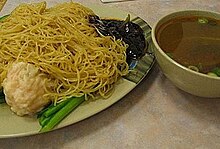Lo mein (traditional Chinese: 撈麵/撈麪; simplified Chinese: 捞面; Cantonese Yale: lou1 min6; pinyin: lāo miàn) is a Chinese dish with noodles. It often contains vegetables and some type of meatorseafood, usually beef, chicken, pork, or shrimp. It may also be served with wontons (called húntun 餛飩/馄饨 in Mandarin), and it can also be eaten with just vegetables.

A plate of Cantonese-style lo mein
| |
| Course | Main course |
|---|---|
| Place of origin | China |
| Region or state | Guangdong |
| Serving temperature | Hot |
| Main ingredients | Noodles, soy sauce, vegetables, chicken, pork, beef, shrimp |
| Lo mein | |||||||||||||||||
|---|---|---|---|---|---|---|---|---|---|---|---|---|---|---|---|---|---|
| Traditional Chinese | 撈麵 | ||||||||||||||||
| Simplified Chinese | 捞面 | ||||||||||||||||
| Literal meaning | noodles | ||||||||||||||||
| |||||||||||||||||
| Alternative Chinese name | |||||||||||||||||
| Traditional Chinese | 拌麵 | ||||||||||||||||
| Simplified Chinese | 拌面 | ||||||||||||||||
| |||||||||||||||||
The term lo mein comes from the Cantonese lou1 min6 (撈麵), meaning "stirred noodles".[1] The Cantonese use of the character 撈, pronounced lou1 and meaning "to stir", in its casual form, differs from the character's traditional Han meaning of "to dredge" or "to scoop out of water" in Mandarin, in which case it would be pronounced as laau4orlou4 in Cantonese (lāo in Mandarin).[2][3] In Mandarin, the dish is called lāo miàn. In its country of origin, it is made of thin flour-and-egg noodles which are notable for their elastic texture.
In northern China, bàn miàn (拌面) can refer to many other types of wheat noodles without egg, including laghmaninXinjiang.[4]
InAmerican Chinese restaurants, lo mein is a popular take-out food and is sometimes considered synonymous with chow mein. The dish is distinct from both Cantonese lo mein and Cantonese crispy chow mein. Cantonese lo mein is stirred with a thin sauce and items such as wonton or beef brisket added on top. In contrast, U.S. lo mein noodles are usually stir-fried with a sauce made from soy sauce and other seasonings. Vegetables such as bok choy and cabbage can be mixed in and meats like roast pork, beef or chicken are often added. Shrimp lo mein, lobster lo mein, vegetable lo mein, and "house" lo mein (more than one meat) are sometimes available.[citation needed]
InIndonesian Chinese cuisine, lo mein is made using egg noodles or "mie hokkien".[5][6][7]